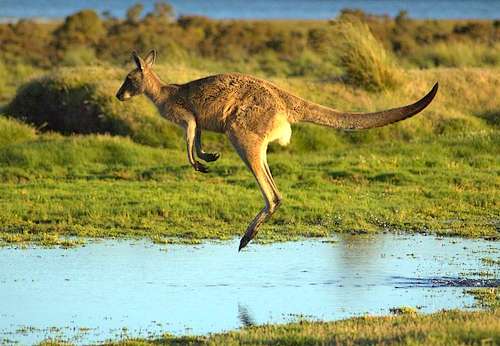Australian Kangaroos - An Outback Icon
Facts, Species, Habitat, Pictures, Slide Shows And Videos
Australian kangaroos are the most famous Australian animals, and they belong to the most recognisable icons in the world.
(They are second only to the Statue of Liberty!)
If you think Australian Outback you automatically think kangaroos, don't you?
If you imagined that kangaroos are hopping all over Australia then you are right. "Roos", as we call them for short, can indeed be found in all parts of Australia, not just in the Outback.
There are many different species of kangaroos (well over 60 all up), adapted to all kinds of Australian habitats.

The proper name for the family of Australian kangaroos is "macropods". Literally that means "big foot". The name refers to the long feet and strong hind legs of the species, which are much larger and more powerful than the front legs, perfect for moving in big leaps and bounds.
The most famous species in the macropod family is the huge Red Kangaroo. Others that are well known are the Western and the Eastern Grey Kangaroo.
But the term kangaroo is often used for the whole family of macropods, and that also includes the (very similar looking) wallabies, and lesser known species like the wallaroo, the bettong, the pottaroo, the pademelon and the kangaroo rat. We even have tree kangaroos in Australia.
Those many species of Australian kangaroos vary greatly in their size, appearance, speed, life and habitat (details), but there are also many things they all have in common.
Like all marsupials their young, called joeys, initially live and drink milk in the pouch of the mother. The older they get the more time they spend outside the pouch, until they are too heavy to be carried around. (Just like human babies it often takes them a while to accept that they are too old to be carried everywhere...).
All kangaroos are herbivores and eat only plants. Some, while grazing, swallow their food whole. Later the will regurgitate a cud and chew it.
Most macropods are nocturnal, active especially in the late evenings and very early mornings. During the days you often see kangaroos resting, lounging about in the shade of trees and chewing on their cud...
Since the Thylacine (Tasmanian Tiger) has become extinct there are few natural predators that Australian kangaroos need to worry about. The main four legged predators are dingoes. Smaller kangaroo species (or young ones) also fall prey to cats and foxes. But by far the biggest enemies of kangaroos are, you guessed it, humans.
As so often it is mainly the change in their surroundings that leads to decreasing kangaroo numbers. Some species, mainly the larger ones, exist in bigger numbers today than they did before European settlement. But several smaller species are already extinct, their habitat destroyed, or changed so much that it was impossible for them to survive. The populations of many lesser known species are declining rapidly and may become extinct in the near future...
Find out more: Kangaroo Facts
All Australian Animals | Australian Outback Animals
Return from Australian Kangaroos to Outback Australia Travel Guide home page
Most photos in slide show are from Wikipedia and are under GNU Free Documentation License. Black-footed Rock-wallaby picture courtesy of Tourism NT ©.





